2.清华大学环境学院, 北京 100084
2.School of Environment, Tsinghua University, Beijing 100084, China
持久性有机污染物(persistent organic pollutants,POPs),是一类具有高毒性、 难降解、 生物蓄积性和半挥发性,对人体健康和环境具有严重危害的天然或人工合成的有机污染物质. POPs具有持久性和半挥发性,使得其可长时间存在于环境中并通过水、 大气或者其他介质全球迁移,目前各国研究者已经在世界范围内检测到了POPs的分布,甚至是人烟稀少的青藏高原[1, 2]、 两极地区[3~5]、 远海[6]等地. 而高纬度或高海拔地区(尤其是离人类活动比较近的高海拔山区),由于其温度低,常常成为POPs类化合物的蓄积储存区[7].
本研究选取有机氯农药(organochlorine pesticides,OCPs)和多环芳烃(polycyclic aromatic hydrocarbons,PAHs)作为研究对象. OCPs是历史上最早最大规模使用过的高效广谱杀虫剂,虽已禁用,但在环境中仍然具有较大的残留量. PAHs广泛分布于环境各介质中,而环境中的PAHs主要是由化石燃料等的不完全燃烧、 汽车尾气排放等人为活动产生的[8],被认为是人类活动影响自然环境的良好指示剂[9].
青藏高原总面积250万 km2,平均海拔4000~5000 m,常年低温,素有“世界屋脊”和“第三极”之称. 由于高原特殊的地理环境,当地工农业生产活动相对稀少,本地污染排放相对较小. 青藏高原周边国家与地区,尤其是印度和中国,曾在历史上大量生产与使用过有机氯农药,而且人口急剧膨胀正在快速工业化,煤和石油等化石燃料的燃烧、 汽车尾气排放、 垃圾焚烧等人为活动将释放大量PAHs等污染物到地表和大气环境中. 而高原的气候呈明显的季节性分布,冬季受西风环流的影响,夏季受控于印度季风[10],尤其是藏东南,在印度季风的影响下,降雨充沛,植被繁茂. 因此,青藏高原周边国家与地区环境是青藏高原潜在的污染源,青藏高原是研究POPs大气长距离传输的天然实验室,并可为POPs的全球迁移提供参考信息.
土壤是环境中污染物的重要蓄积库,大气中的POPs可通过干湿沉降作用进入土壤,植被叶片也可吸收大气中的POPs并将POPs通过叶片的凋落迁移至土壤. 另外,POPs在大气-土壤之间不断地进行分配,土壤中的POPs可形成二次污染源. 本文选取藏东南色季拉山林下土壤为研究对象,主要目的是: ①研究色季拉山PAHs和OCPs的含量及分布特征; ②探求影响色季拉山POPs分布的因素; ③解析色季拉山POPs的主要来源.
1 材料与方法 1.1 样品采集2012年8月于藏东南林芝县境内色季拉山(29°10′N~30°15′N,93°12′E~95°35′E)采集了土壤样品,阴坡(背风坡)8个,阳坡(迎风坡)7个,采样信息见图 1和表 1. 每个样品由采样点位周围30m范围内至少6个子样混合组成. 样品采集好之后用铝箔包裹好冷藏运输至实验室. 土壤样品经过冷冻干燥后用研磨磨细为80目,保存在-20℃的冰箱,直到测样分析.
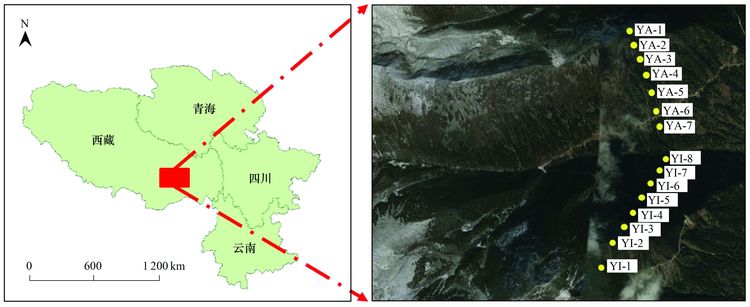
|
图 1 采样点位置示意 Fig. 1 Geographic location of sampling sites |
|
|
表 1 采样点信息和土壤总有机碳含量 Table 1 Information of sampling site and total organic carbon for soils (TOC) |
1.2 材料与试剂
二氯甲烷和正己烷等有机试剂均为农残级,J.T.Baker公司生产. 硅胶: Merck公司生产,在550℃下活化12 h后用浓硫酸配置成30%(质量分数)的酸性硅胶或者用超纯水配置成3%(质量分数)的去活硅胶. 弗罗里土: Sigma-Aldrich公司生产,在180℃下活化16 h待用. 氧化铝: Sigma-Aldrich公司生产,在450℃下活化20 h后用2%(质量分数)的超纯水去活. 无水硫酸钠: 天津津科精细化工研究所生产,在550℃下活化6 h.
多环芳烃标准溶液[美国EPA 16种优控PAHs: 萘、 苊烯、 苊、 芴、 菲、 蒽、 荧蒽、 芘、 苯并(a)蒽、![]()
取2 g土样与10 g无水硫酸钠混匀后,加入回收率指示物氘代多环芳烃100 ng,用加速溶剂萃取仪(DIONEX ASE 350) 萃取,萃取溶剂为二氯甲烷-正己烷(1∶1,体积比)的混合溶剂,萃取温度为100℃,萃取压力为1500 psi,循环次数为3次. 萃取液经旋转蒸发仪浓缩至2 mL,并过硅胶-氧化铝复合柱(从上至下依次为6 g 3%的去活硅胶+4 g 2%的去活氧化铝+5 g无水硫酸钠)净化,再先后用10 mL正己烷与50 mL二氯甲烷∶正己烷(2∶3,体积比)的溶液进行洗脱. 将上述洗脱液浓缩后转移至K-D瓶中,用高纯氮气缓慢浓缩至0.2 mL,并转移至进样瓶,定容至0.5 mL. 仪器分析前加入进样内标二氟联苯(200 ng).
1.3.2 有机氯农药同样的取2 g土样与10 g无水硫酸钠混匀后,加入回收率指示物PCB209和TCmX各10 ng,萃取方法同上. 萃取液旋转蒸发仪浓缩至2 mL,并过酸性硅胶-弗罗里土复合柱(从下至上依次为6 g 30%的酸性硅胶+6 g 弗罗里土+5 g无水硫酸钠)净化,洗脱及后续操作同PAHs净化过程. 仪器分析前加入进样内标八氯萘 (10 ng).
1.4 仪器分析 1.4.1 多环芳烃PAHs的定量分析采用安捷伦7890-5975型气相色谱-质谱仪(GC-MS),配有EI源. 色谱柱为DB-5MS(30 m×0.25 mm×0.25 μm); 载气为高纯氦气,流速为1.2mL·min-1; 进样口温度: 280℃; 进样量: 1 μL,不分流进样模式; 升温程序为60℃保持2 min,再以6℃·min-1的速率升至300℃,并保持10 min; 离子源和四级杆的温度分别为300℃和180℃; 定量分析选用选择离子模式(SIM),并用内标法定量.
1.4.2 有机氯农药样品中有机氯农药的分析采用安捷伦Agilent 7890气相色谱,检测器为Ni63 μECD. 采用不同极性的两根色谱柱分别测定,以得到更好的定性结果,提高检测结果的准确度,色谱柱分别为DB-5(60 m×0.25 mm i.d×0.25 μm)和DB-1701(60 m×0.25 mm i.d×0.25 μm); 载气为高纯氦气,载气流速为1.2 mL·min-1,氮气尾吹; 进样量为1 μL,不分流进样; 升温程序为80℃保持1 min,然后以4℃·min-1的速率升至230℃,最后以25℃·min-1的速率升至280℃,并保持10 min; 进样口及检测器温度分别为250℃和300℃.
1.5 质量控制实验过程中保证严格的质量控制. 每7个样品加一个实验室空白及一个平行样测定. 空白中可以检出萘,但含量均远低于样品中的含量. 样品添加标的平均回收率分别为: 萘-d8(84.7%±7.1%),苊烯-d10(74.4%±5.5%),菲-d10(81.3%±7.4%),-d12(81.9%±4.3%),苝-d12(98.1%±13.2%),TCmX(83.6%±6.1%),PCB209(74.9%±4.8%). PAHs测样2份的相对标准偏差是8.54%±8.51%,OCPs测样2份的相对标准偏差为5.45%±6.75%. 多环芳烃与有机氯农药的方法检出限(3倍信噪比)范围分别为: 0.11~0.97ng·g-1和0.01~0.07 ng·g-1. 样品的最终含量经空白扣除后,再用回收率校正.
1.6 土壤总有机碳土壤总有机碳含量(TOC)的测定采用Elementar vario TOC分析仪,氧气助燃,测定温度为950℃.
2 结果与讨论 2.1 PAHs和OCPs的含量水平如表 2所示,色季拉山林下土壤中∑16PAH的含量范围为99.3~1984 ng·g-1,平均值为1017 ng·g-1. 本研究森林土壤中∑16PAH的含量远高于青藏高原西部[11]、 中部[12]、 青藏高原中部-青海[13]以及意大利中部阿尔皮斯山,稍高于藏东南[14]、 长白山[15]、 大王岭高原生态区[16]以及加拿大西部山区[17]土壤PAHs含量,与波兰圣十字山土壤中PAHs的含量相似,但低于欧洲塔特拉山脉土壤PAHs含量. 同时本研究色季拉山土壤中∑15PAHs(除去NAP)的含量范围为79.9~435 ng·g-1(平均值位176.1 ng·g-1),低于奥地利森林土壤PAHs含量[18]. 多环芳烃各单体中,除萘以外,菲、 芴和苊为丰度最大的3种单体,它们分别占∑15PAHs总量的35.7%、 23.6%及13.4%,而大分子量的单体所占比重较小.
|
|
表 2 本研究和其他高山环境土壤中PAHs、 HCHs及DDTs的含量1) /ng·g-1 Table 2 Concentrations of PAHs,HCHs and DDTs in soils samples from this study and other remote mountain areas/ng·g-1 |
HCHs和DDTs的含量分别为0.37~2.07 ng·g-1 (平均值为1.15 ng·g-1) 和0.70~43.9 ng·g-1 (平均值为9.87 ng·g-1). 本研究色季拉山森林土壤HCHs的含量高于青藏高原中部和东部湖泊流域[19]、 卧龙自然保护区[20]、 珠穆朗玛峰[21]、 欧洲山脉[22, 23]及南美州秘鲁安第斯山脉[24]土壤含量,与藏东南[14]、 青藏高原东部[25]、 加拿大洛矶山脉优鹤国家公园[26]的含量相似,但低于加拿大瑞佛史托克山地[26]土壤含量. DDTs的含量低于青藏高原中部[13]、 青藏高原东部[19, 25]及珠穆朗玛峰[21]土壤含量,而与藏东南[14]土壤含量相当. ∑4DDT(o,p′-DDT、 p,p′-DDT、 p,p′-DDD、 p,p′-DDE)的含量范围为0.64~41.6 ng·g-1(平均值位9.18 ng·g-1),高于卧龙自然保护区[20]及欧洲比利牛斯山[22]土壤含量,与欧洲塔特拉山脉[22]及泰德峰[23]土壤含量相似.
2.2 对比色季拉山阴坡和阳坡PAHs和OCPs的组成及空间分布特征从图 2(b)可以看出色季拉山阴坡和阳坡土壤∑16PAH中2环和3环化合物占总重量的85%以上,而大分子量的5环和6环化合物所占比例很小(小于5%),表明挥发性强的PAHs更易通过大气远距离传输迁移至偏远地区. 图 3(a)和3(b)分别为色季拉山阴坡和阳坡∑15PAHs的含量分布,可以看出在阴坡YI-5~8和阳坡YA-4~7土壤∑15PAHs的分布趋势较一致,且均在YI-6和YA-5出现较大量的4环化合物. 但是阴坡∑15PAH主要以3环化合物为主,4环化合物含量很小(除YI-6点),YI-6处高含量的4环化合物主要来源于的贡献,而阳坡∑15PAHs不仅含有大量3环化合物,也含有大量的4环化合物,YA-5处高含量的4环化合物主要来源于荧蒽,且阴坡5~6 环PAHs的百分含量高于阳坡,说明阴坡和阳坡PAHs可能具有不同的污染来源,也可能是阳坡温度较高较低质量的PAHs挥发所致.
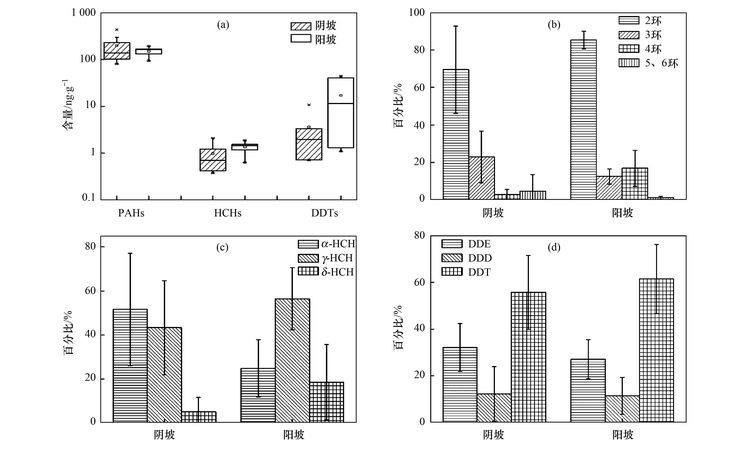
|
图 2 色季拉山土壤阴坡和阳坡PAHs和OCPs的含量及单体百分比特征 Fig. 2 Concentrations and composition of PAHs and OCPs in soils from shade and south-facing slopes of Shergyla Mountain |
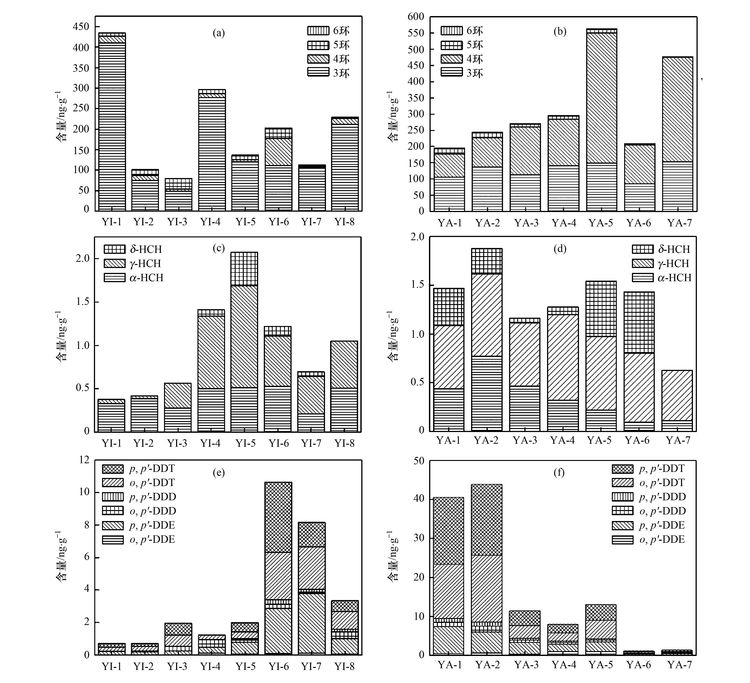
|
图 3 色季拉山阴坡和阳坡土壤中污染物的含量分布及组成 Fig. 3 Concentrations and components of PAHs and OCPs in shade slope and south-facing slope soils of Shergyla Mountain |
色季拉山阴坡和阳坡土壤HCHs的主要单体是α-HCH和γ-HCH,β-HCH和δ-HCH的含量较低,这一结果和Zhu等[31]关于色季拉山大气HCHs的研究结果一致,但阳坡土壤HCHs的含量高于阴坡,如图 2(a)所示. 从图 2(c)可以看出,色季拉山阴坡和阳坡土壤中HCHs的组分存在差异,虽然阴坡和阳坡均以α-HCH和γ-HCH为主,但是阴坡中α-HCH的百分含量稍高于γ-HCH的含量,而阳坡中γ-HCH的百分含量远高于α-HCH的含量. 图 3(c)和3(d)为阴坡和阳坡HCHs的空间分布图,从中可以看出,阴坡HCHs的最大值出现在YI-5处,该点两侧采样点HCHs的含量逐渐降低,且YI-1和2两点γ-HCH相对于α-HCH的含量显著低于阴坡其他采样点,说明阴坡YI-1~2 采样点HCHs来源可能不同于YI-3~8; 阳坡HCHs的最大含量在YA-2,且α-HCH与γ-HCH的含量和沿着YA-2~7一直在降低,α-HCH与γ-HCH含量比沿着YA7~1增大,这可能是因为YA-7附近有γ-HCH的污染源,或者是高海拔YA-1长时间残留的γ-HCH转化为了α-HCH,亦或者是γ-HCH在光照的作用下降解了. 综上可知,色季拉山阴坡和阳坡HCHs的来源可能存在差异,同时光照也可能影响HCHs的组分.
研究区域色季拉山阴坡和阳坡土壤DDTs的主要单体为o,p′-DDT、 p,p′-DDT、 p,p′-DDE,且阴坡和阳坡DDTs的组成较一致,其中DDT的百分比含量最高,DDE次之,DDD的百分比含量最低,如图 2(d)所示,但色季拉山阳坡土壤DDTs的含量明显高于阴坡土壤含量,如图 2(a)所示. 图 3(e)和3(f)是阴坡和阳坡DDTs的空间分布,从中可以看出阴坡DDTs和阳坡DDTs的空间分布完全不同,阴坡DDTs的最大含量值出现在YI-6处,DDTs的含量沿着YI-8~1先增大后降低; 而阳坡DDTs的最大值出现在YA-2处,DDTs的含量沿着YA-7~2增大,可能是地形或者污染源影响了DDTs在色季拉山阴坡和阳坡的分布.
2.3 PAHs和OCPs随TOC及海拔的梯度变化POPs具有亲脂性,且众多的研究论述了TOC可以影响POPs的分布[32]. 表 1显示研究区域TOC的含量为3.6%~12.36%,其中阴坡土壤TOC含量为7.71%±1.71%,阳坡土壤TOC含量为7.56%±3.10%. 图 4为色季拉山阴坡和阳坡POPs与TOC的线性回归分析,显示阴坡土壤POPs含量和TOC含量在P<0.05的水平上无显著相关性(6环PAHs除外),而阳坡土壤OCPs和5、 6环PAHs的含量与TOC的含量在P<0.05的水平上显著相关.
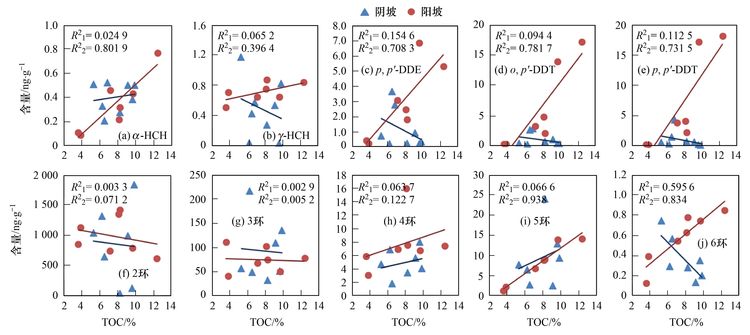
|
图 4 阴坡和阳坡OCPs和PAHs与TOC的相关性 Fig. 4 Correlation between the concentrations of OCPs and PAHs in shade slope and south-facing slope soils and TOC of sampling sites |
目前各国研究者已经在全球偏远地区检测到了POPs的存在[1,33~38]. Blais等[39]对加拿大西部落基山脉雪样POPs的研究论证了“高山冷捕获效应”的存在,随后的众多研究[40~46]证实POPs具有“逆海拔”[7]分布现象. 且众多研究发现高山独特的季风环境[2, 47]、 森林覆盖[48]、 雾和降雨、 地形[41]等都有可能影响POPs在高山中的分布特征.
图 5为色季拉山阴坡和阳坡POPs(TOC校正)与海拔的线性回归分析. 从中可以看出,阳坡土壤α-HCH和DDTs类化合物含量随着海拔的升高而升高,并且与海拔在P<0.05的水平上呈显著相关性,而阳坡土壤γ-HCH的含量随海拔升高而降低,这可能是环境中的γ-HCH在光的作用下较容易降解[49]或者长时间残留的γ-HCH转化为了α-HCH所致; 而阴坡土壤HCHs和DDTs的含量随着海拔的升高含量降低,并且HCHs和DDTs与海拔并无显著相关性,色季拉山阴坡和阳坡OCPs随海拔的这种不同分布可能是由于阴坡和阳坡的地形或污染物来源不同. 色季拉山阴坡和阳坡土壤PAHs随海拔的变化均差异较大. 阳坡低质量的PAHs(2和3环)随着海拔的升高含量降低,高质量的PAHs(5和6环)随海拔的升高含量升高,并且5环PAHs与海拔在P<0.05的水平上显著相关. 阴坡土壤中4和5环PAHs随着海拔的升高而升高,但相关性不显著,其余化合物[苯并(k)荧蒽和苯并(a)芘除外]随着海拔稍有降低. 值得注意的是强致癌化合物苯并(a)芘(BaP)含量在色季拉山阴坡和阳坡均随着海拔的升高而升高.
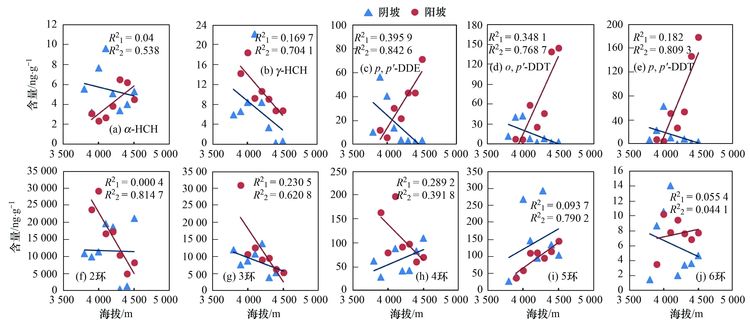
|
图 5 阴坡和阳坡OCPs和PAHs随海拔的分布 Fig. 5 Distribution pattern of OCPs and PAHs in shade slope and south-facing slope soils with altitude of sampling sites |
综上可知,TOC和海拔在一定程度上可以影响色季拉山阴坡和阳坡POPs的分布,同时污染源、 地形及光照等影响因子对污染物分布的影响不可忽略.
2.4 来源解析POPs的特征单体比值一定程度上可以指示POPs的来源、 使用历史或环境行为. PAHs的主要来源是化石燃料、 生物质燃烧等的不完全燃烧. 燃料种类的不同和燃烧条件的差异包括燃烧温度、 氧气含量和通风条件等都会造成不同PAHs组成特征. 因此,PAHs的组成特征可以用来识别PAHs的来源. 此外,特定燃料燃烧产生特定的PAHs比值,PAHs比值是鉴定PAHs来源快捷而有效的途径.
有研究指出FLT相对于PYR稳定,当FLT/PYR大于1指示燃烧来源,当FLT/PYR小于1指示石油残留来源[50]. 阳坡各采样点FLT/PYR的值均大于1,说明阳坡PAHs主要来源于燃烧. 阴坡采样点YI-2和YI-6的FLT/PYR小于1,可能是受到了石油残留的影响,阴坡其余各采样点FLT/PYR均大于1. Yunker等[51]总结出了PAHs的3类来源以及相应临界比值. 天然石油源: [FLT/(FLT+PYR)<0.4,IcdP/(IcdP+BghiP)<0.2]; 石油燃烧源: [FLT/(FLT+PYR)0.4~0.5,IcdP/(IcdP+BghiP)0.2~0.5]; 生物质燃烧源(草、 木材、 煤):[FLT/(FLT+PYR)>0.5,IcdP/(IcdP+BghiP)>0.5],如图 6(d)所示,可以推断研究区域阳坡和阴坡大部分采样点PAHs主要来源于生物质和石油的不完全燃烧,但是阴坡少数采样点则有石油源的影响.

|
图 6 HCHs、 DDTs和PAHs的特征单体比值 Fig. 6 Special diagnostic ratios of HCH,DDTs and PAHs in the sampling site |
有机氯农药特征单体的比值通常用来区分农药的输入种类和输入时间等信息. 工业品HCHs中4种单体所占比例分别为α-HCH(60%~70%),β-HCH(5%~12%),γ-HCH(10%~15%),δ-HCH(6%~10%),α/γ-HCH的比值介于5~7之间[25, 52, 53]. 由于其对生态环境以及人类健康所产生的负面影响,工业HCHs陆续被各国禁止使用. 随后,γ-HCH含量高达99%以上的林丹[53]代替工业HCHs在农业中大量使用,因此环境中α/γ-HCH值能较好地反映HCHs的来源情况. 一般来说,当α/γ-HCH的比值小于3时表示有大量林丹的使用. 本研究色季拉山阴坡和阳坡土壤中,除阴坡高海拔处的两个点外,α/γ-HCH的比值均明显小于3,如图 6(a)所示,说明阴坡和阳坡HCHs的来源的确存在差异,且研究区域的HCHs主要来自于历史上工业品HCHs和林丹大量使用,是二者的共同输入所致.
已有研究表明,DDT会在环境中逐步降解为更稳定的DDD(厌氧产物)和DDE(有氧产物),利用DDT与其降解产物的比值可以反映DDTs排放在环境中的“新旧”,其中p,p′-DDT/p,p′-DDE的比值小于1,表示DDTs是历史使用源,p,p′-DDT/p,p′-DDE的比值大于1,说明研究区域有DDTs“新”源的输入. 本研究中DDT主要通过有氧降解,降解为p,p′-DDE. 如图 6(b)所示,色季拉山阳坡大部分采样点p,p′-DDT/p,p′-DDE大于1,说明阳坡DDTs受“新”源的影响,而阴坡大部分采样点p,p′-DDT/p,p′-DDE小于1,说明阴坡DDTs主要来源于“旧”源[25].
尽管DDTs已经在大部分国家(包括中国)禁用多年,但DDT仍然作为三氯杀螨醇的媒介物进行生产,特别是2002年世界卫生组织准许DDTs在一些疟疾高发的热带国家(如印度等南亚国家)使用,以保障公共卫生健康. 工业品DDTs中含有约15% o,p′-DDT和85% p,p′-DDT(两者比值介于0.17~0.23) [20, 54],三氯杀螨醇中o,p′-DDT的含量高于p,p′-DDT,两者比值约为7[20],而本研究中o,p′-DDT/p,p′-DDT的比值远高于工业品DDTs中的0.23,如图 6(c),可推断研究区域有三氯杀螨醇的输入. 综上可知研究区域DDTs是历史工业品DDTs和三氯杀螨醇共同贡献的结果.
PAHs中2~3环低质量的化合物为主要成分,且研究区域三氯杀螨醇及“新”DDTs的存在,说明研究区域有POPs类污染物的输入,而且很可能是大气远距离源的输入. 青藏高原气候呈季节性变化,夏季受印度季风的影响(6~9月),冬季则受控于西风环流(11月~次年3月),气候呈明显的暖湿季和干冷季. 本研究区域色季拉山位于藏东南,受显著的印度季风影响,降雨丰富,森林繁茂. 而印度次大陆在历史上曾大量地生产与使用OCPs,至今为了防止疟疾仍有使用[55],并且印度次大陆正在快速城镇化与工业化,PAHs等以工业产品或者副产品大量释放在了环境中. 这些在印度次大陆环境中存在的高含量的HCHs、 DDTs和PAHs等污染物会随着印度季风迁移传输至研究区域,并在低温的研究区域沉降富集.
3 结论本研究通过分析青藏高原色季拉山阴坡和阳坡土壤中多环芳烃和有机氯农药的污染水平,发现藏东南色季拉山PAHs和OCPs污染较严重. 通过对比阴坡和阳坡PAHs、 HCHs和DDTs的组成和空间分布,发现色季拉山阴坡和阳坡PAHs、 HCHs和DDTs的污染源存在差异,且TOC、 海拔及地形影响PAHs和OCPs在空间上的分布. 污染源解析进一步证实阴坡和阳坡存在污染源的差异,且通过特征单体比值分析,发现研究区域PAHs主要来自于生物质和化石燃料的不完全燃烧; OCPs除受历史使用工业品HCHs和DDTs的影响外,还存在林丹、 三氯杀螨醇等农药产品的贡献. 最后结合当地的气候条件和污染物的单体特征,可知研究区域的污染物主要来自印度季风从印度次大陆的大气远距离输送.
 2016, Vol. 37
2016, Vol. 37


